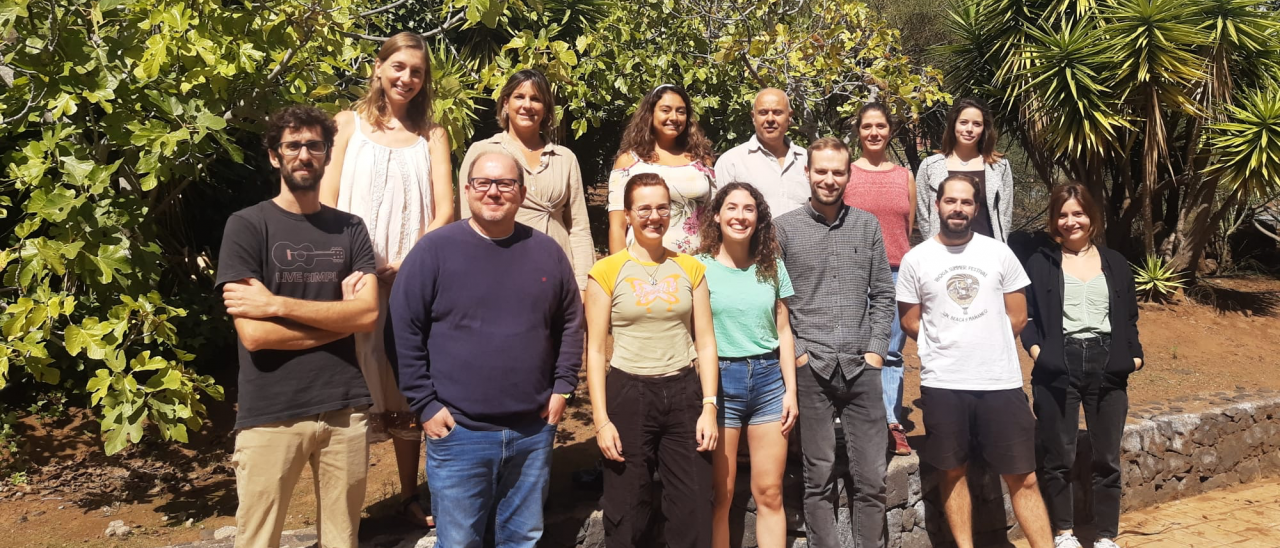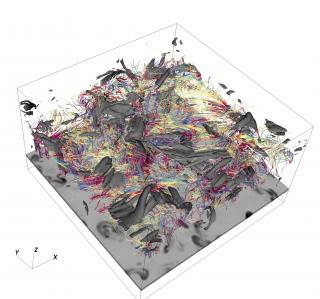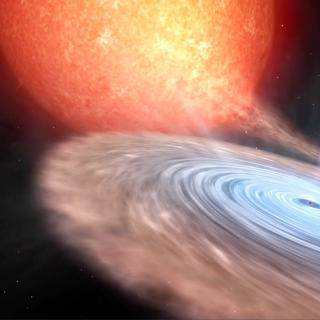Subvenciones relacionadas:
General
Bienvenida a la página web del grupo de investigación Traces of Galaxy Formation.
Somos un grupo de investigación amplio, diverso y muy activo cuyo objetivo principal es entender la formación de galaxias en el Universo de una manera lo más completa posible. Con el estudio detellado de las poblaciones estelares como bandera, estamos constantemente buscando y desarrollando nuevas herramientas e ideas que nos permitan entender cómo las galaxias han llegado a convertirse en lo que hoy observamos.
Una historia de formación compleja, como la que se espera describa la evolución de las galaxias, necesita de un acercamiento multidisciplinar para ser entendida. Nuestro grupo en el IAC está compuesto por personal investigador de gran experiencia en simulaciones cosmológicas, estudios dinámicos, análisis de poblaciones estelares y caracterizaciones morfológicas de galaxias tanto locales como a alto corrimiento al rojo. Combinamos distintas alternativas (e.g. observaciones y teoría o procesos de evolución secular y cosmológica) para poder alcanzar en los próximos años una visión consistente de los mecanismos físicos que regulan la formación de las galaxias.
Dentro de este esquema general, estamos principalmente centrados en el estudio de tres líneas centrales:
- Modelos de síntesis de poblaciones estelares
- Desarrollo de modelos de poblaciones estelares
- Métodos de análisis para el estudio de poblaciones estelares
- Universalidad de la función inicial de masa (IMF)
- Evolución cósmica de galaxias
- Evolución de galaxias masivas
- Poblaciones estelares en distintos entornos
- Ciencia a bajo brillo superficial
- Simulaciones númericas y aprendizaje automático
- Procesos evolutivos en galaxias cercanas
- Agujeros negros como moduladores de la formación estelar
- Cartogrtafiados locales
- Cinemática estelar y modelos dinámicos
Si quieres ponerte en contacto o trabajar con el grupo, por favor, envía un correo al investigador principal (Ignacio Martín-Navarro ignacio.martin [at] iac.es (ignacio[dot]martin[at]iac[dot]es)).
Miembros
Resultados
Esta es una muestra de algunos de nuestros resultados destacados más recientes:
- Local variations of the stellar velocity ellipsoid - II. The effect of the bar in the inner regions of Auriga galaxies. Walo et al. 2022, MNRAS (https://ui.adsabs.harvard.edu/abs/2022MNRAS.513.4587W)
- Anisotropic satellite galaxy quenching modulated by black hole activity. Martín-Navarro et al. 2021, Nature (https://ui.adsabs.harvard.edu/abs/2021Natur.594..187M)
- Evaluating hydrodynamical simulations with green valley galaxies. Angthopo et al. 2021, MNRAS (https://ui.adsabs.harvard.edu/abs/2021MNRAS.502.3685A)
- Sub one per cent mass fractions of young stars in red massive galaxies. Salvador-Rusiñol et al. 2020, Nature Astronomy (https://ui.adsabs.harvard.edu/abs/2020NatAs...4..252S)
- Detection of young stellar populations in apparently quenched low-mass galaxies using red spectral line indices. de Lorenzo-Cáceres et al. 2020, MNRAS (https://ui.adsabs.harvard.edu/abs/2020MNRAS.498.1002D)
Actividad científica
Publicaciones relacionadas
-
Rejuvenation triggers nuclear activity in nearby galaxiesFeedback, in particular from active galactic nuclei (AGNs), is believed to play a crucial role in the evolution of galaxies. In the local Universe, many galaxies with an AGN are indeed observed to reside in the so-called green valley, usually interpreted as a transition phase from a blue star-forming to a red quenched state. We use data from theMartín-Navarro, Ignacio et al.
Fecha de publicación:
62022 -
Low-metallicity globular clusters in the low-mass isolated spiral galaxy NGC 2403The globular cluster (GC) systems of low-mass late-type galaxies, such as NGC 2403, have been poorly studied to date. As a low mass galaxy (M * = 7 × 10 9 M ⊙), cosmological simulations predict NGC 2403 to contain few, if any, accreted GCs. It is also isolated, with a remarkably undisturbed HI disc. Based on candidates from the literature, SloanForbes, Duncan A. et al.
Fecha de publicación:
52022 -
Strong CO absorption features in massive ETGsMassive Early-Type Galaxies (ETGs) in the local Universe are believed to be the most mature stage of galaxy evolution. Their stellar population content reveals the evolutionary history of these galaxies. However, while state-of-the-art Stellar Population Synthesis (SPS) models provide an accurate description of observed galaxy spectra in theEftekhari, Elham et al.
Fecha de publicación:
52022 -
Inferring the helium abundance of extragalactic globular clusters using integrated spectraThe leading method for the determination of relevant stellar population parameters of unresolved extragalactic Globular Clusters is through the study of their integrated spectroscopy, where Balmer line-strength indices are considered to be age sensitive. Previously, a splitting in the highly optimized spectral line-strength index H β o was observedLeath, H. J. et al.
Fecha de publicación:
52022 -
Implications for galaxy formation models from observations of globular clusters around ultradiffuse galaxiesWe present an analysis of Hubble Space Telescope observations of globular clusters (GCs) in six ultradiffuse galaxies (UDGs) in the Coma cluster, a sample that represents UDGs with large effective radii (R e), and use the results to evaluate competing formation models. We eliminate two significant sources of systematic uncertainty in theSaifollahi, Teymoor et al.
Fecha de publicación:
42022 -
The dark side of galaxy stellar populations - I. The stellar-to-halo mass relation and the velocity dispersion-halo mass relationThe growth and properties of galaxies are thought to be closely connected to the ones of their host dark matter haloes. Despite the importance of this so-called galaxy-halo connection, the potential role of dark matter haloes in regulating observed galaxy properties remains yet to be fully understood. In this work, we derive the ages, metallicitesScholz-Díaz, Laura et al.
Fecha de publicación:
42022 -
CO-CAVITY pilot survey: Molecular gas and star formation in void galaxiesContext. Voids are the most under-dense large-scale regions in the Universe. Galaxies inhabiting voids are one of the keys for understanding the intrinsic processes of galaxy evolution, as external factors such as multiple galaxy mergers or a dense self-collapsing environment are negligible. Aims: We present the first molecular gas mass survey ofDomínguez-Gómez, J. et al.
Fecha de publicación:
22022 -
Observed versus simulated halo c-M<SUB>vir</SUB> relationsThe concentration - virial mass relation is a well-defined trend that reflects the formation of structure in an expanding universe. Numerical simulations reveal a marked correlation that depends on the collapse time of dark matter haloes and their subsequent assembly history. However, observational constraints are mostly limited to the massive endLeier, Dominik et al.
Fecha de publicación:
22022 -
From blue cloud to red sequence: evidence of morphological transition prior to star formation quenchingWe present a study of a sample of 254 clusters from the SDSS-DR7 Yang Catalogue and an auxiliary sample of field galaxies to perform a detailed investigation on how galaxy quenching depends on both environment and galaxy stellar mass. Our samples are restricted to 0.03 ≤ z ≤ 0.1 and we only consider clusters with log (M halo/M ⊙) ≥ 14. ComparingSampaio, V. M. et al.
Fecha de publicación:
12022 -
The Fornax3D project: Planetary nebulae catalogue and independent distance measurements to Fornax cluster galaxiesExtragalactic planetary nebulae (PNe) offer a way to determine the distance to their host galaxies thanks to the nearly universal shape of the planetary nebulae luminosity function (PNLF). Accurate PNe distance measurements rely on obtaining well-sampled PNLFs and the number of observed PNe scales with the encompassed stellar mass. This meansSpriggs, T. W. et al.
Fecha de publicación:
92021 -
Capturing the Physics of MaNGA Galaxies with Self-supervised Machine LearningAs available data sets grow in size and complexity, advanced visualization tools enabling their exploration and analysis become more important. In modern astronomy, integral field spectroscopic galaxy surveys are a clear example of increasing high dimensionality and complex data sets, which challenges the traditional methods used to extract theSarmiento, Regina et al.
Fecha de publicación:
112021 -
Chronos: A NIR spectroscopic galaxy survey to probe the most fundamental stages of galaxy evolutionWe propose a dedicated, ultra-deep spectroscopic survey in the near infrared (NIR), that will target a mass-limited sample of galaxies during two of the most fundamental epochs of cosmic evolution: the formation of the first galaxies (at z ≳ 6; cosmic dawn), and at the peak of galaxy formation activity (at redshift z∼1-3; cosmic noon). By way ofFerreras, I. et al.
Fecha de publicación:
62021 -
Physically Motivated Fit to Mass Surface Density Profiles Observed in GalaxiesPolytropes have gained renewed interest because they account for several seemingly disconnected observational properties of galaxies. Here we study whether polytropes are also able to explain the stellar mass distribution within galaxies. We develop a code to fit surface density profiles using polytropes projected in the plane of the sky (propols)Sánchez Almeida, Jorge et al.
Fecha de publicación:
112021 -
Rejuvenation triggers nuclear activity in nearby galaxiesFeedback, in particular from active galactic nuclei (AGN), is believed to play a crucial role in the evolution of galaxies. In the local Universe, many galaxies with an AGN are indeed observed to reside in the so-called green valley, usually interpreted as a transition phase from a blue star-forming to a red quenched state. We use data from the
Fecha de publicación:
102021Bibcode -
Outflows from starburst galaxies with various driving mechanisms and their X-ray propertiesOutflows in starburst galaxies driven by thermal-mechanical energy, cosmic rays, and their mix are investigated with 1D and 2D hydrodynamic simulations. We show that these outflows could reach a stationary state, after which their hydrodynamic profiles asymptotically approach previous results obtained semi-analytically for stationary outflowYu, B. P. Brian et al.
Fecha de publicación:
122021 -
X-ray bubbles in the circumgalactic medium of TNG50 Milky Way- and M31-like galaxies: signposts of supermassive black hole activityThe TNG50 cosmological simulation produces X-ray emitting bubbles, shells, and cavities in the circumgalactic gas above and below the stellar discs of Milky Way- and Andromeda-like galaxies with morphological features reminiscent of the eROSITA and Fermi bubbles in the Galaxy. Two-thirds of the 198 MW/M31 analogues inspected in TNG50 at z = 0 showPillepich, Annalisa et al.
Fecha de publicación:
122021 -
Anomaly detection in Hyper Suprime-Cam galaxy images with generative adversarial networksThe problem of anomaly detection in astronomical surveys is becoming increasingly important as data sets grow in size. We present the results of an unsupervised anomaly detection method using a Wasserstein generative adversarial network (WGAN) on nearly one million optical galaxy images in the Hyper Suprime-Cam (HSC) survey. The WGAN learns toStorey-Fisher, Kate et al.
Fecha de publicación:
122021 -
NGC 5746: Formation history of a massive disc-dominated galaxyThe existence of massive galaxies lacking a classical bulge has often been proposed as a challenge to ΛCDM. However, recent simulations propose that a fraction of massive disc galaxies might have had very quiescent merger histories, and also that mergers do not necessarily build classical bulges. We test these ideas with deep MUSE observations ofMartig, Marie et al.
Fecha de publicación:
122021 -
Fornax 3D project: Assessing the diversity of IMF and stellar population maps within the Fornax ClusterThe stellar initial mass function (IMF) is central to our interpretation of astronomical observables and to our understanding of most baryonic processes within galaxies. The universality of the IMF, suggested by observations in our own Milky Way, has been thoroughly revisited due to the apparent excess of low-mass stars in the central regions ofMartín-Navarro, I. et al.
Fecha de publicación:
102021 -
Introducing the LBT Imaging of Galactic Halos and Tidal Structures (LIGHTS) survey. A preview of the low surface brightness Universe to be unveiled by LSSTWe present the first results of the LBT Imaging of Galaxy Haloes and Tidal Structures (LIGHTS) survey. LIGHTS is an ongoing observational campaign with the 2 × 8.4 m Large Binocular Telescope (LBT) aiming to explore the stellar haloes and the low surface brightness population of satellites down to a depth of μ V ∼ 31 mag arcsec −2 (3σ in 10″ × 10″Trujillo, Ignacio et al.
Fecha de publicación:
102021



